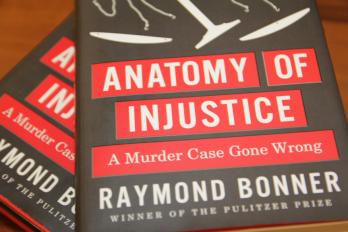Anatomy of Injustice: Author Tells of “Murder Case Gone Wrong”
March 23, 2012
By Elisabeth Donovan, 3L
“This book was not a labor of love but a labor of outrage,” said Pulitzer Prize winning journalist Raymond Bonner, as he spoke to Thomas Jefferson School of Law on March 22 students about his latest book Anatomy of Injustice- A Murder Case Gone Wrong.
The event was co-sponsored by the Criminal Law Society, National Lawyers Guild, and Center for Law and Social Justice.
The inspirational but harrowing book helped free Edward Lee Elmore, an innocent, mentally retarded black man who spent 30 years in prison and faced the death penalty. Elmore was 23-years-old with an I.Q. of 61 when he was convicted in South Carolina of brutally murdering a 76-year-old white woman in 1982.
Bonner, who is also an attorney, chronicled the case from the initial trial through the day Elmore walked out of prison a free man. According to Bonner, two weeks before the murder occurred, Elmore performed work at the victim’s house. He was arrested on the basis of a fingerprint next to the door and a check written to him by the victim after Elmore had done some work for her. A jailhouse snitch also testified that Elmore had confessed to him. Ninety days later, as a result of what Bonner called overzealous prosecution, incompetent defense attorneys, and fabricated evidence, Elmore was sentenced to the death penalty.
Second-year law student Diana Holt, who had become an attorney despite the odds being stacked against her, devoted much of her career to proving Elmore’s innocence. Holt had a traumatic past of her own, as she was a victim of horrific sexual abuse and domestic violence, and was admitted to law school despite the fact that she had a felony on her criminal record.
“Diana had a special relationship with Elmore because of the experiences in her past,” Bonner said.
During the post-conviction release hearing, Holt challenged the evidence that was used to convict Elmore. Bonner extensively detailed this evidence during the presentation, and believes that the police planted a substantial amount of it.
Among Bonner’s revelations: The prosecution in the case argued that 53 pubic hairs were found on the victim’s bed, and claimed they had pictures. However, the pictures were of the bed in the guest bedroom, and the baggie with the hairs was never sealed. When Elmore was booked, police took a substantial sample of his head and pubic hairs. The police also did not take the sheets as evidence.
The prosecution also argued that hair found on the victim’s body belonged to Elmore, although it later came to light that this hair belonged to a Caucasian after the hair had been mysteriously “missing’ for 16 years. Also, other than the one print on the outside doorway, none of fingerprints taken at the scene belonged to Elmore.
Despite the fact that the evidence used to convict Elmore was tainted, Bonner said the judge at the release hearing was still not convinced he should walk out as a free man.
“There’s a mindset among prosecutors and some judges that once a person is convicted they are guilty and no amount of evidence will show otherwise,” Bonner said.
The 4th Circuit Court of Appeals eventually called the conviction a case of “deceit and outright dishonesty by the police.”
By 2009, Elmore no longer faced the death penalty because he was deemed “mentally retarded” by the courts. Eventually, after prosecutors read Bonner’s book, they agreed to set Elmore free if he entered a plea deal, according to the author. Elmore walked out of prison on March 2, 2012 a free man at last.
“Elmore got off by pleading guilty to a crime he didn’t commit,” Bonner said. “The day Elmore walked out of prison I said, ‘I don’t dare call this justice. This is not justice.’”
“This event was inspirational but disheartening at the same time,” 3L Brittney Gallina said. “It’s sad that there are so many attorneys who are more focused on their track record rather than seeking justice”
When asked what Elmore is doing now, Bonner replied: “He doesn’t have a future, but he doesn’t have a past either.”



